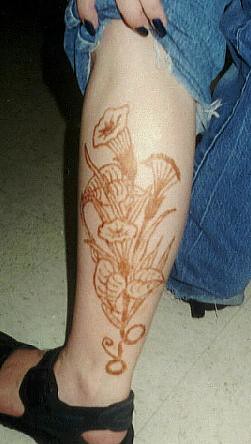Mehndi is the application of Henna as a temporary form of skin decoration in South Asia, as well as by expatriate communities from these areas. Mehendi decorations became fashionable in the West in the late 1990s, where they are sometimes called henna tattoos. Henna is typically applied during special occasions like weddings and festivals. It is usually drawn on the palms and feet, where the color will be darkest because the skin contains higher levels of keratin which binds temporarily to lawsone, the colorant of henna. Henna was originally used as a form of decoration mainly for brides.
The term henna tattoo is inaccurate, because tattoos are defined as permanent surgical insertion of pigments underneath the skin, as opposed to pigments resting on the surface as is the case with mehndi.
There is evidence that mehndi as a ceremonial art form originated in ancient India. Intricate patterns of mehndi are typically applied to brides before wedding ceremonies. The bridegroom is also painted in some parts of India, Pakistan, Nepal, Bangladesh and Sudan. In Rajasthan (north-west India), the grooms are given designs that are often as elaborate as those for brides. In Assam, apart from marriage, it is broadly used by unmarried women during Rongali bihu (there’s no restrictions to the married ones).
See Some Amazing Mehndi Designs As following:
![[33.jpg]](https://blogger.googleusercontent.com/img/b/R29vZ2xl/AVvXsEiDYNqx-1-IO8JU9W656Tajia6PU99xWu4xfJekCeTWaSPbLB6itTlVMllj3N3Cgp_N1odDmiR_Kd9GcQVm30GyhrOfp1RJK_vjiBFSbT34S6F2uhx2utv17_-VeQzjgSeTq38W7PvIH8Q/s1600-rw/33.jpg)
![[bridal-mehndi.jpg]](https://blogger.googleusercontent.com/img/b/R29vZ2xl/AVvXsEhr02I6757Wen5MoHNvU_EQBkn3wdv9sr34vkzPq0F66peK48z98nCr4tTzEpDxCyrh-Fe7F1-cYXwzF7IQdUMz9uUahyphenhyphenWqX0ll_3O1Ui4i33u75smzPOgCk_ChFT4_82fwjhyphenhypheniyML3C6Y-/s1600-rw/bridal-mehndi.jpg)




![[34.jpg]](https://blogger.googleusercontent.com/img/b/R29vZ2xl/AVvXsEjKxuy4SrWjtpG5SngGSu1lLYOrOCiE-mAeohLmXQq5VMGrasKutl4ivTltaYqf3QYVmziqojqBUtxD9V18EOEOZQg5NJSPybjkZqmW24642ytke9xN2mEm1WDoLrMUwLgNfak59faCLZY/s1600-rw/34.jpg)
![[35.jpg]](https://blogger.googleusercontent.com/img/b/R29vZ2xl/AVvXsEjgkMLVOETae8FG0ay1wnybJDnXmlsAm0fyYNEh-LjrVferZMLy-VuWoEK72zVhddhZ159qvNbh887crGEOO4pcuylwCknRN8O-L39wXY3uOUUJpIAm5UZxYm-U7cQ5kKpLrLLrXFAG_rc/s1600-rw/35.jpg)
![[34.png]](https://blogger.googleusercontent.com/img/b/R29vZ2xl/AVvXsEgCUSsHD7qibZeIhhegLP46MkuEURs2LiVuxXZ_9RJ5NmX60VOhDGWwzrKrIMx9sgIysyif380PhxXZ-T0odFsHljX87bZv37MXRruK6MjwPPllc2MYz80uDJbst4OcZpy6cdVioQYFL5ty/s1600-rw/34.png)
![[6.jpg]](https://blogger.googleusercontent.com/img/b/R29vZ2xl/AVvXsEgoD0OiDfzUA9B46OaXknIviiW2bP8NyGljpcWEZoxmsijM0S603eIgNqd5SHqQQOv_M9DQCxOPsyaBzI_4yQ_Wk_-NJWrLt3FVx9mCu1fHtSNEy1MeCuoYO2ZSvvjTu3H-AXWkm8loWrV5/s1600-rw/6.jpg)
![[5.jpg]](https://blogger.googleusercontent.com/img/b/R29vZ2xl/AVvXsEgTxLYLHhw6xInpbiHM2kA15_QMfa_fizaQY_YLvgY7b0s38vYJ2wk_UzBAfvuEX7WJIvCSGsAIoDTVnq28MTLKsFo1rUkmZu2_ioYrCMhSq65IsuwCfMlDR7McWB8I7nSA0UgiOU-2_Est/s1600-rw/5.jpg)

























-Tattoo-Designs+(3).jpeg)






















































3 Comments
in the world Amazing things photo
that good